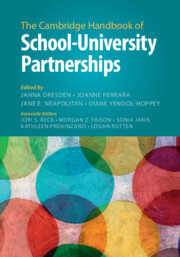Book contents
- The Cambridge Handbook of School–University Partnerships
- The Cambridge Handbook of School–University Partnerships
- Copyright page
- Contents
- Figures
- Tables
- Contributors
- Foreword
- Preface
- Acknowledgments
- Part I The History and Conceptual Foundations of School–University Partnerships
- Part II Teachers and Learning to Teach in School–University Partnerships
- Part III Equity and Student Learning in School–University Partnerships
- Part IV Leadership in School–University Partnerships
- Part V Community Schools as School–University Partnerships
- Part VI Inquiry and Innovation in School–University Partnerships
- Introduction to Part VI: Inquiry and Innovation in School–University Partnerships
- 37 Exploring the Promise and Possibility of Innovation in Professional Development Schools
- 38 Locating Practitioner Inquiry within the Professional Development School Movement
- 39 Teacher Inquiry in Professional Development Schools
- 40 Leveraging Action Research to Create Innovative P-12 Systems Change in School–University Partnerships
- 41 Professional Development Schools as Networked, Systemic Innovations
- 42 Pre-Collegiate Grow Your Own Programs as Innovative School–University Partnerships
- 43 What’s Needed Now
- 44 Commentary on Part VI: Inquiry and Innovation in School–University Partnerships
- Part VII Funding, Policy, and the Politics of School–University Partnerships
- Part VIII Looking at School–University Partnerships across Geographic and Cultural Borders
- Index
- References
43 - What’s Needed Now
A Narrative Review of Research on School–University Partnerships and Professional Development Schools
from Part VI - Inquiry and Innovation in School–University Partnerships
Published online by Cambridge University Press: 05 November 2025
- The Cambridge Handbook of School–University Partnerships
- The Cambridge Handbook of School–University Partnerships
- Copyright page
- Contents
- Figures
- Tables
- Contributors
- Foreword
- Preface
- Acknowledgments
- Part I The History and Conceptual Foundations of School–University Partnerships
- Part II Teachers and Learning to Teach in School–University Partnerships
- Part III Equity and Student Learning in School–University Partnerships
- Part IV Leadership in School–University Partnerships
- Part V Community Schools as School–University Partnerships
- Part VI Inquiry and Innovation in School–University Partnerships
- Introduction to Part VI: Inquiry and Innovation in School–University Partnerships
- 37 Exploring the Promise and Possibility of Innovation in Professional Development Schools
- 38 Locating Practitioner Inquiry within the Professional Development School Movement
- 39 Teacher Inquiry in Professional Development Schools
- 40 Leveraging Action Research to Create Innovative P-12 Systems Change in School–University Partnerships
- 41 Professional Development Schools as Networked, Systemic Innovations
- 42 Pre-Collegiate Grow Your Own Programs as Innovative School–University Partnerships
- 43 What’s Needed Now
- 44 Commentary on Part VI: Inquiry and Innovation in School–University Partnerships
- Part VII Funding, Policy, and the Politics of School–University Partnerships
- Part VIII Looking at School–University Partnerships across Geographic and Cultural Borders
- Index
- References
Summary
This review of research on school–university partnerships (SUPs) begins by presenting an overview of the relevant literature including scoping reviews, research mapping, systematic reviews and traditional literature reviews published between 1997 and 2023. The review found three questions were typically addressed in the studies; the first focused on the characteristics of successful partnerships, the second on the outcomes of partnership work and the third on the extent to which partnerships focused on issues of equity. In addition, the review noted that since the earliest reviews of research on PDSs there has been a concern with the quality of that research. A number of suggestions are offered to improve the quality of research including attention to the development of appropriate measures for evaluation, an appreciation for complexity, a close investigation of local context, and a stance of patience and humility. The chapter closes with technical and ethical guidelines for future research.
Keywords
Information
- Type
- Chapter
- Information
- The Cambridge Handbook of School–University Partnerships , pp. 696 - 721Publisher: Cambridge University PressPrint publication year: 2025
References
Accessibility standard: WCAG 2.1 AA
Why this information is here
This section outlines the accessibility features of this content - including support for screen readers, full keyboard navigation and high-contrast display options. This may not be relevant for you.Accessibility Information
Content Navigation
Allows you to navigate directly to chapters, sections, or non‐text items through a linked table of contents, reducing the need for extensive scrolling.
Provides an interactive index, letting you go straight to where a term or subject appears in the text without manual searching.
Reading Order & Textual Equivalents
You will encounter all content (including footnotes, captions, etc.) in a clear, sequential flow, making it easier to follow with assistive tools like screen readers.
Visual Accessibility
You will still understand key ideas or prompts without relying solely on colour, which is especially helpful if you have colour vision deficiencies.
Structural and Technical Features
You gain clarity from ARIA (Accessible Rich Internet Applications) roles and attributes, as they help assistive technologies interpret how each part of the content functions.
